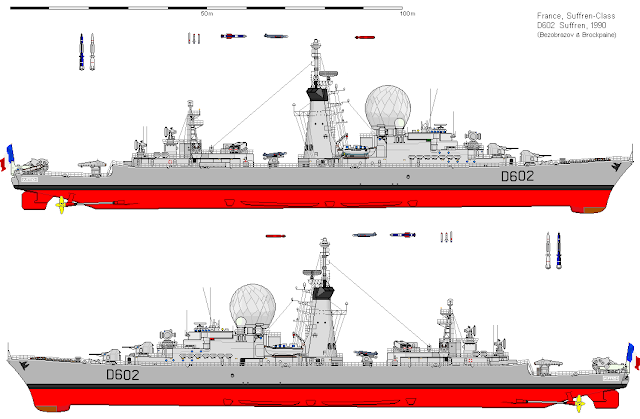Il MALAFON (contrazione di MArine LAtécoère FONd) è stato sviluppato per rispondere alle capacità di rilevamento dei sottomarini, notevolmente aumentate con l'arrivo del sonar rimorchiato.
Poiché i siluri, i mortai e altri lanciarazzi hanno una portata molto limitata, si è pensato di mettere a punto un missile dotato di siluro ASW.
Iniziarono quindi gli studi per rispondere al programma. Numerosi lanci furono effettuati nel centro di prova di Ile du Levant e sull'Ile d'Oléron. Dopo i test operativi effettuati sulla nave La Galissonnière, il sistema entrò in servizio nella Marine Nationale nel 1966: fu il primo missile di design nazionale utilizzato dalla Marina francese.
Il suo utilizzo si interruppe nel 1997 per essere sostituito con l'elicottero Lynx che lo soppiantò nella caccia ai sommergibili. Il suo successore designato, il Milas non entrerà mai in servizio nella Marine Nationale in quanto la Francia si è ritirò dal programma nel 1998 lasciando il progetto all’Italia.
Il Malafon ha la forma di un aliante, la cui parte anteriore è costituita da un siluro antisommergibile di tipo L4 convenzionale.
Veniva installato su di una rampa circolare mobile e veniva lanciato con una elevazione di 15° verso il bersaglio designato. Veniva azionato durante i primi 4 secondi di volo da un doppio booster, rilasciato una volta raggiunta la velocità di 230 metri al secondo (828 km / h) e l'altitudine di 200 metri. Il missile terminava la sua corsa sospesa, stabilizzata in quota da un pilota automatico. Nei pressi dell'obiettivo, l'apertura di un paracadute frenava improvvisamente l'arma e provocava la separazione del siluro che, guidato dal proprio sonar attivo, si lanciava alla ricerca dell’obiettivo ostile descrivendo una traiettoria subacquea a spirale.
Durante il suo volo, il Malafon poteva ricevere, tramite collegamento radio, elementi di correzione della rotta destinati a mantenerlo nella direzione desiderata. Questi elementi erano elaborati da un computer, sovrapponendo la posizione del sottomarino fornita dal sonar e quella del missile trasmessa dalla sorveglianza di superficie o dal radar di tiro. Una luce luminosa, alle estremità di ogni ala, facilitava il controllo visivo della traiettoria.
Le struttura molto ingombrante del sistema d’arma antisom consentiva solo di l’imbarco su navi di un certo tonnellaggio.
Il sistema ASW comprendeva:
- apparecchiature elettroniche in parte situate nel centro operativo;
- una rampa di lancio telecomandata che poteva essere ruotata in modo circolare;
- Un imponente deposito in coperta per la manutenzione che poteva contenere 13 missili smontati che dovevano essere assemblati solo prima di essere messi sulla rampa.
Il Malafon era progettato per la guerra antisommergibile a medio e lungo raggio. Poteva anche essere utilizzato, se necessario, contro obiettivi di superficie. Fu esclusivamente costruito per la marina francese, che lo imbarcò sulle seguenti unità navali:
- due fregate Suffren,
- 3 fregate Tourville,
- 5 navi di scorta T47 Revised tipo ASM On Estrées,
- Nave La Galissonnière,
- fregata tipo F65 Aconit.
ENGLISH
The MALAFON (contraction of MArine LAtécoère FONd) was developed to respond to the detection capabilities of submarines, which increased significantly with the arrival of the towed sonar.
Since torpedoes, mortars and other rocket launchers have a very limited range, it was decided to develop a missile equipped with an ASW torpedo.
Studies began to respond to the program. Numerous launches were carried out in the test centre at Ile du Levant and on the Ile d'Oléron. After the operational tests carried out on the ship La Galissonnière, the system entered service in the National Marine in 1966: it was the first national design missile used by the French Navy.
Its use stopped in 1997 and it was replaced by the Lynx helicopter, which replaced it in submarine hunting. Its designated successor, the Milas, will never enter service in the Marine Nationale as France withdrew from the program in 1998 leaving the project to Italy.
The Malafon is shaped like a glider, the front of which is a conventional L4 anti-submarine torpedo.
It was installed on a circular mobile ramp and launched with a 15° elevation towards the designated target. It was operated during the first 4 seconds of flight by a double booster, released once it reached a speed of 230 meters per second (828 km / h) and an altitude of 200 meters. The missile ended its suspended run, stabilized at altitude by an autopilot. Near the target, the opening of a parachute suddenly slowed down the weapon and caused the torpedo to separate and, guided by its own active sonar, launched itself in search of the hostile target, describing a spiral underwater trajectory.
During its flight, the Malafon could receive, via radio link, course correction elements designed to keep it in the desired direction. These elements were processed by a computer, superimposing the position of the submarine provided by sonar and that of the missile transmitted by surface surveillance or firing radar. A luminous light, at the ends of each wing, facilitated visual control of the trajectory.
The very cumbersome structure of the anti-submarine weapon system only allowed boarding on ships of a certain tonnage.
The ASW system included:
- electronic equipment partly located in the operations center;
- a remote-controlled launch pad that could be rotated in a circular fashion;
- a massive maintenance deck depot that could hold 13 missiles that had to be disassembled and assembled only before being put on the ramp.
The Malafon was designed for medium and long-range anti-submarine warfare. It could also be used, if necessary, against surface targets. It was built exclusively for the French navy, which embarked it on the following vessels:
- two Suffren frigates,
- 3 Tourville frigates,
- 5 escort vessels T47 Revised type ASM On Estrées,
- Ship La Galissonnière,
- frigate type F65 Aconit.
(Web, Google, Wikipedia, You Tube)
















Nessun commento:
Posta un commento
Nota. Solo i membri di questo blog possono postare un commento.